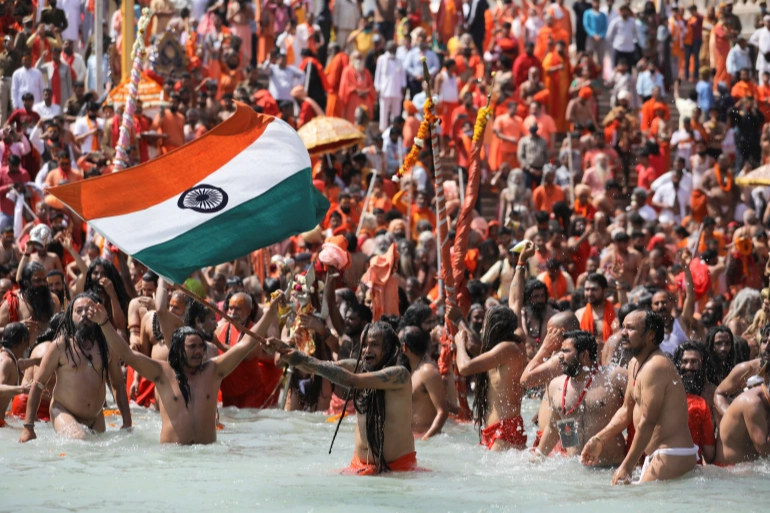
A Hindu holy man waves the Indian flag as he takes a dip in the Ganges River during the Kumbh Mela or Pitcher Festival, in Haridwar, India [Photo: Anushree Fadnavis/Reuters]
New Delhi, April 10 (RHC)-- India’s COVID-19 cases have soared 13-fold in barely two months, a vicious second wave propelled by open disregard for safety protocols in much of the vast country. The country on Friday reported 131,968 new COVID-19 infections, a record increase for a third-straight day, data from the health ministry showed. Deaths rose by 780 to a total of 167,642.
With an overall tally at 13.06 million, India’s overall caseload was the third-highest globally, behind the United States and Brazil. Election rallies led by Prime Minister Narendra Modi, main opposition leader Rahul Gandhi and other important political figures, as well as crowded festivals and religious gatherings have contributed to the record resurgence of the new coronavirus.
After quelling the first surge late last year, India’s leaders let down their guard. Allowing or even encouraging dangerous behavior, they underestimated the virus, reopening the economy too fast and too broadly, experts say.
Days after the federal health minister declared India’s COVID-19 outbreak contained in late January, Mumbai reopened its huge suburban train network and authorities let tens of thousands of visitors into stadiums for international cricket matches.
Many of the South Asian nation’s 1.35 billion people ignored masks and social distancing, while politicians including Modi and Home Minister Amit Shah greeted hundreds of thousands of mostly maskless supporters at election rallies.
Political parties have largely flouted COVID-19 rules during campaigns for multi-phase elections in four big states and one federal territory that started last month. “Political leaders are themselves responsible” for the resurgence by allowing the packed rallies, said Dr Subhash Salunke, a former World Health Organization official who advises the worst-hit state, Maharashtra. “The upward trend is going to be there for another couple of weeks.”
Health Minister Harsh Vardhan told officials of 11 of the worst-hit states this week that “people largely gave up on COVID-appropriate behaviour, became very careless” as activity resumed. “There have been elections, religious gatherings, reopening of offices, lots of people travelling, attending social functions, not following rules, little mask-wearing in functions like weddings, even on crowded buses and trains,” he told a video conference.
But Vardhan himself has faced criticism for tweeting dozens of images and videos of party rallies. Authorities have refused to call off a weeks-long Hindu festival, held once every 12 years on the banks of the Ganga river in the northern state of Uttarakhand.
A successfully run Kumbh Mela or Pitcher festival, which is expected to draw millions of devotees, is seen as crucial for the campaign of Modi’s Hindu nationalist party in the state, which votes next year.
With 13.6 million cases, India is just behind Brazil and well below the United States, which has recorded more than 30 million infections. India’s COVID-19 deaths are above 166,000, although its death rate is one of the lowest in the world, partly because of its relatively young population.

